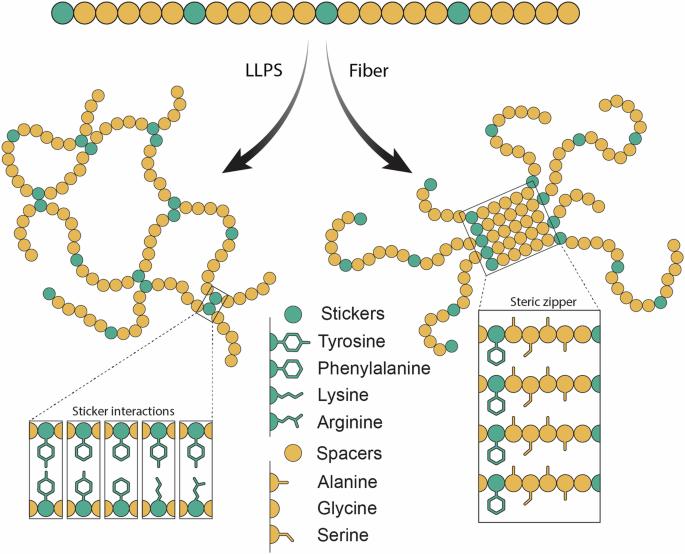蜘蛛丝蛋白质的液-液结晶相分离
IF 5.9
2区 化学
Q1 CHEMISTRY, MULTIDISCIPLINARY
引用次数: 0
摘要
蛋白质的液-液相分离(LLPS)可被视为介于分散溶液和固体纤维之间的中间溶解度机制。虽然 LLPS 已被描述为几种致病性淀粉样蛋白,但最近的证据表明,它与功能性淀粉样蛋白同样相关。在此,我们回顾了将蜘蛛丝蛋白(spidroins)与 LLPS 及其在纺丝过程中的作用联系起来的证据。主要的安瓿酸蛛丝蛋白在其重复区域的粘合剂和间隔物的介导下进行 LLPS。在纺丝过程中,刺络蛋白液滴从液态转变为结晶态。剪切力、离子成分的改变以及 pH 值的变化会使胶束状的螺环蛋白集合体形成越来越有序的液晶相。重复区域中聚丙氨酸区域之间的相互作用最终产生了成熟拖丝纤维特有的β结晶结构。基于这些发现,我们推测液-液晶相分离(LLCPS)可以描述主要安瓿酸盐蛛丝在纺丝过程中相变的分子和宏观特征,并推测其他类型的蚕丝是否可能使用类似的机制从液态涂料转化为固态纤维。蛋白质的液-液相分离(LLPS)可被视为介于分散溶液和固体纤维之间的中间溶解度体系,与致病性和功能性淀粉样蛋白都有关系。在此,作者回顾了将蜘蛛丝蛋白(spidroins)与 LLPS 及其在纺丝过程中的作用联系起来的证据。本文章由计算机程序翻译,如有差异,请以英文原文为准。

Liquid-liquid crystalline phase separation of spider silk proteins
Liquid-liquid phase separation (LLPS) of proteins can be considered an intermediate solubility regime between disperse solutions and solid fibers. While LLPS has been described for several pathogenic amyloids, recent evidence suggests that it is similarly relevant for functional amyloids. Here, we review the evidence that links spider silk proteins (spidroins) and LLPS and its role in the spinning process. Major ampullate spidroins undergo LLPS mediated by stickers and spacers in their repeat regions. During spinning, the spidroins droplets shift from liquid to crystalline states. Shear force, altered ion composition, and pH changes cause micelle-like spidroin assemblies to form an increasingly ordered liquid-crystalline phase. Interactions between polyalanine regions in the repeat regions ultimately yield the characteristic β-crystalline structure of mature dragline silk fibers. Based on these findings, we hypothesize that liquid-liquid crystalline phase separation (LLCPS) can describe the molecular and macroscopic features of the phase transitions of major ampullate spidroins during spinning and speculate whether other silk types may use a similar mechanism to convert from liquid dope to solid fiber. Liquid-liquid phase separation (LLPS) of proteins can be considered an intermediate solubility regime between disperse solutions and solid fibers, relevant to both pathogenic and functional amyloids. Here, the authors review the evidence that links spider silk proteins (spidroins) and LLPS and its role in the spinning process.
求助全文
通过发布文献求助,成功后即可免费获取论文全文。
去求助
来源期刊

Communications Chemistry
Chemistry-General Chemistry
CiteScore
7.70
自引率
1.70%
发文量
146
审稿时长
13 weeks
期刊介绍:
Communications Chemistry is an open access journal from Nature Research publishing high-quality research, reviews and commentary in all areas of the chemical sciences. Research papers published by the journal represent significant advances bringing new chemical insight to a specialized area of research. We also aim to provide a community forum for issues of importance to all chemists, regardless of sub-discipline.
 求助内容:
求助内容: 应助结果提醒方式:
应助结果提醒方式:


